25 August
2021
Chinese classical furniture is an important component of traditional Chinese culture. All the furniture, including tables, chairs, beds and couches, condense the nature culture, wise craftsmanship and spiritual profundity of thousands of years to deliver an elegant, far-reaching and poetic beauty that has extended from ancient to modern times. Despite the long years, they still emit an intoxicating charm.
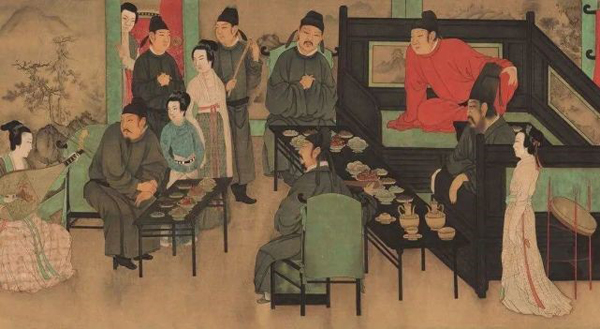
The picture is sourced from the Internet. Please contact us for deletion thereof in case of any infringement.
Based on their different functions, Chinese classical furniture is roughly classified into 5 categories: beds and couches; cabinets and shelves; tables and desks; chairs and stools; miscellaneous.
1. Beds and Couches
Including: Babu bed, frame bed, Arhat couch, Arhat bed, chaise couch.
Chinese craftsmen call a piece of bedding with only the body, but nothing upon it as “couch” or small bed. A couch is normally narrow to allow only one person to sleep or lie on it. It terms of placement, it may be placed in a study or kiosk rather than being fixed in a position like a modern bed. In terms of style, they are divided into the categories of Babu beds, Arhat beds, frame beds and chaise couches. In ancient China, wealthy and influential families usually used Babu bed and frame bed as dowry, which however are rarely seen today. Instead, the simple and elegant Arhat beds still find extensive use in the furniture of traditional or new Chinese style.

Source of Picture: Yashixuan at 4FC05-06 of Louvre Furniture Expo
2. Cabinets and Shelves
Including:
For bedroom: top box cabinet, official cap cabinet;
For study: Wanli cabinets, net back bookshelves, door bookcases, Qianqiu bookshelves;
For jewelry: Miniature curio cabinets, jewelry cabinets, antique cabinets;
For kitchen: Doorless cabinets and cupboards.
Ancient cabinets differ from those we see today and are close to the present cases in appearance and functions. In the Han Dynasty, the small cabinets were rectangular, with four feet and an openable cover at the center of the top and was equipped with a hidden lock. In the Tang Dynasty, cabinets became much larger than in the Han Dynasty and could accommodate many articles. In the Song Dynasty, special book cabinets started to bring into being. They are in a square shape, and has a pair of doors in the front and two drawers and three shelves. After the Ming Dynasty, the variety of cabinets and shelves increased gradually.
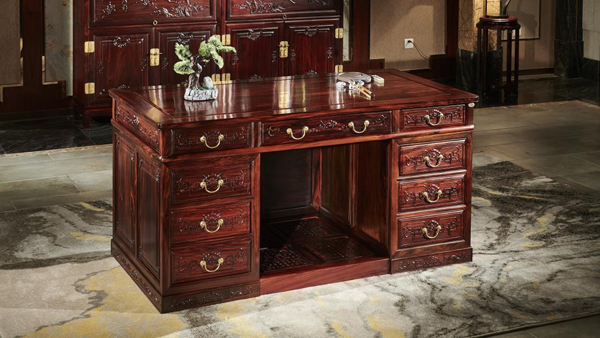
Source of Picture: Huahang Redwood at 4FC18-19 of Louvre Furniture Expo
3. Tables and Desks
Including:
Altars (credences), square tables (or “Eight-Immortal Tables” if they can seat 8 people), round tables, crescent tables, desks, writing desks, painting tables, Chinese lute tables, incense burner tables, Kang tables, bar tables, garden tables, decorative tables.
Taking up a high position in ancient Chinese culture, tables and desks are deemed as the inherited products of a nation that values rituals and the essential tools for reception. Therefore, a system was implemented in all dynasties for the strict grading of tables and desks. For example, altars and credences were used to commemorate deceased ancestors; Eight-Immortal Tables were used to receive important guests; and round tables were used for family reunion.
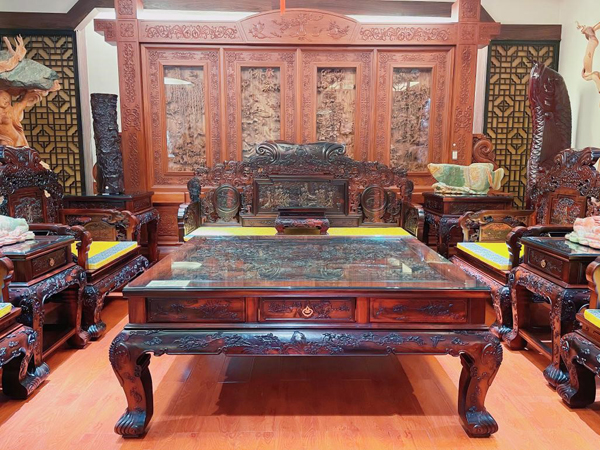
Source of Picture: Minggongxuan at 4FD08-11 of Louvre Furniture Expo
4. Chairs and Stools
Including:
Stools: Square stools, round stools, bar stools, campstools, footstools, plancons, square stools, folding stools and benches.
Chairs: Folding chairs, armchairs, official cap chairs, southern official cap chairs, round-backed chairs, Rose chairs, lantern-hanging chairs and imperial chairs.
Thrones
The chairs and stools of classical Chinese style differ in styles and characteristics in different ages. In the Song Dynasty, they featured a simple and delicate shape, with a reasonable and meticulous structure; high chairs and stools were popular in daily life. In the Ming Dynasty, they carried on the concise and simple shape of the Song Dynasty, but were introduced with innovative craftwork for better functional satisfaction of ergonomic needs. In the Qing Dynasty, they gradually broke away from the style of the Ming Dynasty and became well-known to people with their luxurious shape and carvings.
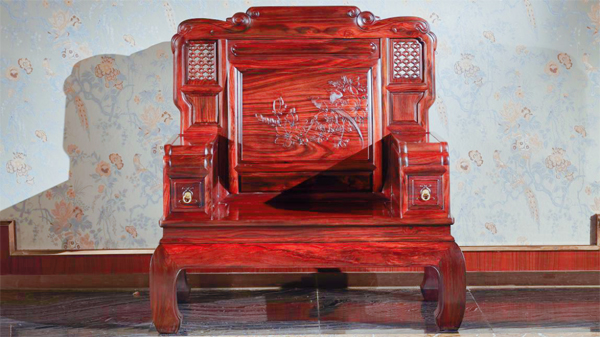
Source of Picture: Huahang Redwood at 4FC18-19 of Louvre Furniture Expo
5. Miscellaneous
Including:
For holding things: bookcases, suitcases, official leather boxes, jewelry cases, writing cases, seal boxes, other boxes, wooden trays, tiered food carriers;
Screens: Floor screens, bed screens, hair combing screens, lantern screens, hanging screens, curved screens;
Stands: Clothes stands, basin stands, mirror stands, candle stands, pedals;
Decorative ornaments: Brush pots, ink boxes, chess pieces pots, bottle seats, dish racks, smoking set and carvings.
Boasting a time-honored history, Chinese classical furniture has given rise to products made in diversified shapes with brilliant craftsmanship in addition to the above classification along with economic and cultural development. It has outstripped any Western country in terms of the number of categories, which defy a one-by-one recognition that would take God knows how long. Therefore, all the remaining categories are here incorporated into “Miscellaneous”.
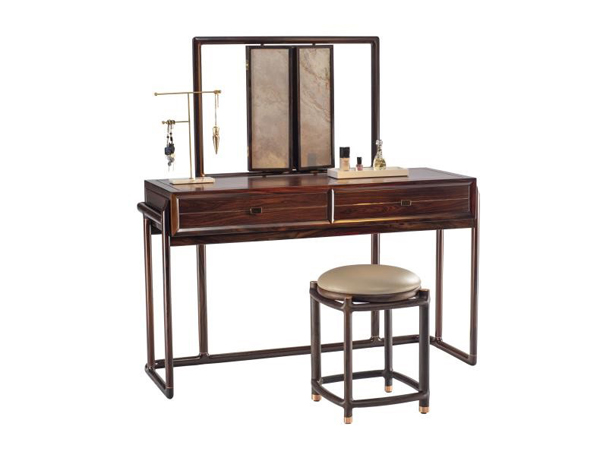
Source of Picture: Yixiang at 3FC10 of Louvre Furniture Expo
Chinese classical furniture, including beds, desks, stools, tables and window screens, is without exception exquisite, resplendent, solid and durable, all reflecting the excellent techniques and super artistic perceptivity of the Chinese craftsmen of all generations. Today, the products that are intended to reach the level of such masterpieces must meet the highest requirements for materials, workmanship, paint and design.

Lourve International Furniture Expo implements a mature environmental protection system, including the commitment to environmental protection supported by 100% prior compensation, announcement of air quality and an air purification system. It has built up consumers’ confidence in creating a nice and healthy home through the multiple guarantees for “quality + after-sales service + shopping environment”.
Chinese classical furniture, made in magnanimous shapes and bestowed with profundity, is the never outdated oriental aesthetics with unique fascination spanning centuries that you, who also long for a superior elegance, can find and appreciate in Louvre Furniture Expo.
In the post-pandemic age, safety and health is still the primary concern of the whole society. As an important “family member” in close contact with us, furniture is of particular interest.
03 December
2020
The annual Double 12 Shopping Carnival is coming. Looking back the Double 11 Shopping Carnival not long ago, furniture became one of the hot industries not affected by the pandemic this year, which is unexpected to many furniture manufactures A furniture manufacturer even said that the rapid growth of sales volume on the domestic market in recent months not only made up the gap at the year beginning, but also brought a year-round growth of about 30%.
14 July
2021
In recent years, parents are increasingly interested in educational tours and theme parent-child camps, which are designed to offer special tourism experience for children.
In the post-pandemic age, safety and health is still the primary concern of the whole society. As an important “family member” in close contact with us, furniture is of particular interest.
The annual Double 12 Shopping Carnival is coming. Looking back the Double 11 Shopping Carnival not long ago, furniture became one of the hot industries not affected by the pandemic this year, which is unexpected to many furniture manufactures A furniture manufacturer even said that the rapid growth of sales volume on the domestic market in recent months not only made up the gap at the year beginning, but also brought a year-round growth of about 30%.
Chinese classical furniture is an important component of traditional Chinese culture. All the furniture, including tables, chairs, beds and couches, condense the nature culture, wise craftsmanship and spiritual profundity of thousands of years to deliver an elegant, far-reaching and poetic beauty that has extended from ancient to modern times. Despite the long years, they still emit an intoxicating charm.

The picture is sourced from the Internet. Please contact us for deletion thereof in case of any infringement.
Based on their different functions, Chinese classical furniture is roughly classified into 5 categories: beds and couches; cabinets and shelves; tables and desks; chairs and stools; miscellaneous.
1. Beds and Couches
Including: Babu bed, frame bed, Arhat couch, Arhat bed, chaise couch.
Chinese craftsmen call a piece of bedding with only the body, but nothing upon it as “couch” or small bed. A couch is normally narrow to allow only one person to sleep or lie on it. It terms of placement, it may be placed in a study or kiosk rather than being fixed in a position like a modern bed. In terms of style, they are divided into the categories of Babu beds, Arhat beds, frame beds and chaise couches. In ancient China, wealthy and influential families usually used Babu bed and frame bed as dowry, which however are rarely seen today. Instead, the simple and elegant Arhat beds still find extensive use in the furniture of traditional or new Chinese style.

Source of Picture: Yashixuan at 4FC05-06 of Louvre Furniture Expo
2. Cabinets and Shelves
Including:
For bedroom: top box cabinet, official cap cabinet;
For study: Wanli cabinets, net back bookshelves, door bookcases, Qianqiu bookshelves;
For jewelry: Miniature curio cabinets, jewelry cabinets, antique cabinets;
For kitchen: Doorless cabinets and cupboards.
Ancient cabinets differ from those we see today and are close to the present cases in appearance and functions. In the Han Dynasty, the small cabinets were rectangular, with four feet and an openable cover at the center of the top and was equipped with a hidden lock. In the Tang Dynasty, cabinets became much larger than in the Han Dynasty and could accommodate many articles. In the Song Dynasty, special book cabinets started to bring into being. They are in a square shape, and has a pair of doors in the front and two drawers and three shelves. After the Ming Dynasty, the variety of cabinets and shelves increased gradually.

Source of Picture: Huahang Redwood at 4FC18-19 of Louvre Furniture Expo
3. Tables and Desks
Including:
Altars (credences), square tables (or “Eight-Immortal Tables” if they can seat 8 people), round tables, crescent tables, desks, writing desks, painting tables, Chinese lute tables, incense burner tables, Kang tables, bar tables, garden tables, decorative tables.
Taking up a high position in ancient Chinese culture, tables and desks are deemed as the inherited products of a nation that values rituals and the essential tools for reception. Therefore, a system was implemented in all dynasties for the strict grading of tables and desks. For example, altars and credences were used to commemorate deceased ancestors; Eight-Immortal Tables were used to receive important guests; and round tables were used for family reunion.

Source of Picture: Minggongxuan at 4FD08-11 of Louvre Furniture Expo
4. Chairs and Stools
Including:
Stools: Square stools, round stools, bar stools, campstools, footstools, plancons, square stools, folding stools and benches.
Chairs: Folding chairs, armchairs, official cap chairs, southern official cap chairs, round-backed chairs, Rose chairs, lantern-hanging chairs and imperial chairs.
Thrones
The chairs and stools of classical Chinese style differ in styles and characteristics in different ages. In the Song Dynasty, they featured a simple and delicate shape, with a reasonable and meticulous structure; high chairs and stools were popular in daily life. In the Ming Dynasty, they carried on the concise and simple shape of the Song Dynasty, but were introduced with innovative craftwork for better functional satisfaction of ergonomic needs. In the Qing Dynasty, they gradually broke away from the style of the Ming Dynasty and became well-known to people with their luxurious shape and carvings.

Source of Picture: Huahang Redwood at 4FC18-19 of Louvre Furniture Expo
5. Miscellaneous
Including:
For holding things: bookcases, suitcases, official leather boxes, jewelry cases, writing cases, seal boxes, other boxes, wooden trays, tiered food carriers;
Screens: Floor screens, bed screens, hair combing screens, lantern screens, hanging screens, curved screens;
Stands: Clothes stands, basin stands, mirror stands, candle stands, pedals;
Decorative ornaments: Brush pots, ink boxes, chess pieces pots, bottle seats, dish racks, smoking set and carvings.
Boasting a time-honored history, Chinese classical furniture has given rise to products made in diversified shapes with brilliant craftsmanship in addition to the above classification along with economic and cultural development. It has outstripped any Western country in terms of the number of categories, which defy a one-by-one recognition that would take God knows how long. Therefore, all the remaining categories are here incorporated into “Miscellaneous”.

Source of Picture: Yixiang at 3FC10 of Louvre Furniture Expo
Chinese classical furniture, including beds, desks, stools, tables and window screens, is without exception exquisite, resplendent, solid and durable, all reflecting the excellent techniques and super artistic perceptivity of the Chinese craftsmen of all generations. Today, the products that are intended to reach the level of such masterpieces must meet the highest requirements for materials, workmanship, paint and design.

Lourve International Furniture Expo implements a mature environmental protection system, including the commitment to environmental protection supported by 100% prior compensation, announcement of air quality and an air purification system. It has built up consumers’ confidence in creating a nice and healthy home through the multiple guarantees for “quality + after-sales service + shopping environment”.
Chinese classical furniture, made in magnanimous shapes and bestowed with profundity, is the never outdated oriental aesthetics with unique fascination spanning centuries that you, who also long for a superior elegance, can find and appreciate in Louvre Furniture Expo.